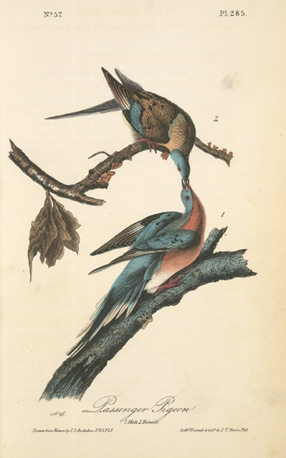

• Intro / Home
• Historical Neighbors
• Street and Backyard
Neighbors
• Park and Green Places
Neighbors
• Shore and Wetlands
Neighbors
• Salt and Freshwater
Neighbors
• Tiny Neighbors
• Unwelcome Neighbors
• Occasional and
Unexpected Neighbors
•
Wildlife Sighting Log
• Resources
• Hours and Tours
• Press Release
• NYPL HOME
| Historical Neighbors | |
When Audubon painted these Passenger Pigeons in 1824,
they were the most numerous birds in the world. According to his
estimation, there were a billion birds in a single flight, which
lasted for three days and stretched over hundreds of miles, blotting
out the sun as the enormous flocks passed overhead. Yet by the end
of the century, the birds were gone, victims of forest destruction
and senseless slaughter. The last Passenger Pigeon, "Martha,"
died in the Cincinnati Zoo on September 1, 1914. Audubon’s illustration appeared first in 1827–38 in
the large-format engraved edition of Birds of America, known
as the "double-elephant folio," and then in the small
(10 1/4" x 6 1/2") lithographed edition.
|
